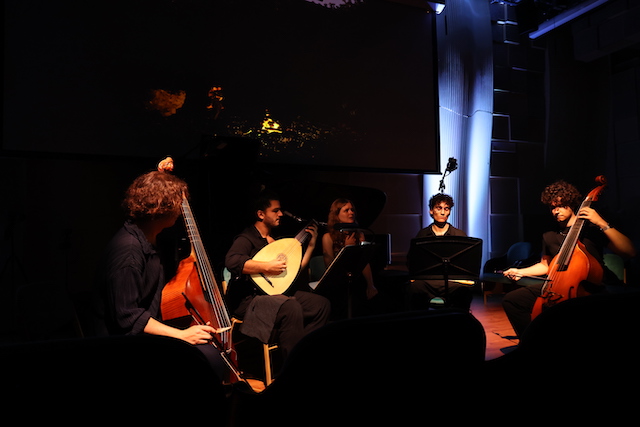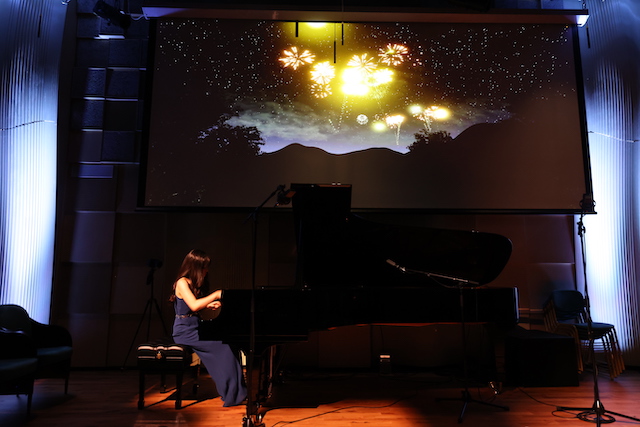Immersive Night Music Show, Makita, Londinium Ensemble, World Heart Beat Embassy Gardens - multimedia musings on a midsummer night | reviews, news & interviews
Immersive Night Music Show, Makita, Londinium Ensemble, World Heart Beat Embassy Gardens - multimedia musings on a midsummer night
Immersive Night Music Show, Makita, Londinium Ensemble, World Heart Beat Embassy Gardens - multimedia musings on a midsummer night
This intriguing musical/visual collaboration was best when it was boldest
To mark this year’s summer solstice, a small audience gathered at London’s newest concert venue, the World Heart Beat Embassy Gardens, a small and perfectly formed hall bristling with “state-of-the-art” acoustics and digital facilities. On a balmy midsummer’s evening, the pianist and composer Rieko Makita invited us to reflect on the different moods and aspects of the night, in a programme that combined music with digital art projections.
Makita is part of the ever-expanding movement in London to explore technology and new venues as a way of taking classical music to different audiences. For this concert – in which she teamed up with the bracingly edgy Londinium Consort (pictured below) – she deployed music ranging from easy crowd-pleasers, like Debussy’s Clair de Lune, to more experimental new compositions as she investigated both the reflective and ebullient sides of life after sunset.
The evening opened with Makita’s own composition, As the sun sets, a meditative piece to mellow the senses as – on a screen above the piano – we contemplated a blood-red sun reflected in water. Then the screen went dark and the aching melodies of African American composer Florence Price’s Night filled the room, stylishly performed by American soprano Anne Sutton and accompanied by Makita.
After this nocturnal amuse bouche, Makita explained to the audience that the first part of the evening was going to be devoted to looking at the more introspective nature of the night. She began with Robert Schumann’s Des Abends from Fantasiestücke, Op 12, the lyrically beautiful, intimate work in D flat major that he wrote in the same year he became engaged to Clara. On the screen, a candlelit bedroom appeared before us with the curtains open to display the moon in the night sky. The projection was tasteful, yet it couldn’t catch the opalescent subtlety of Makita’s performance, in which the cross-rhythms created a gentle sense of fluidity as the melody rang out like a bell.
Such concerns aside, Makita’s overall concept was an engaging one and there were many diverting aspects to the evening. Her performance of Liszt’s Liebestraum No. 3 alternated velvety harmonies with shimmering clouds of notes as the digital projection swirled us into outer space. A glittering execution of Debussy’s Feux d’artifice demonstrated once more that the vibrant colours she generated as a pianist could not be matched by the digital fireworks on screen.
This first part of the evening also featured guest appearances from different members of the young and rising early music ensemble, Londinium Consort. A highlight was Ozgur Kaya’s performance of Lili Boulanger’s Nocturne on the cello, which captured the wildness of her vision at the same time as mining the exquisite lyricism at the piece’s core. For the second part of the evening, Communal Night, the group took command of the programme, interspersing works by the king of melancholy, Renaissance composer John Dowland, with a song by Monteverdi and a composition by Kaya inspired by Gerard Manley Hopkins. The Monteverdi Ohimè, ch’io cado was delivered with enjoyable anarchic vigour by Sutton with an accompaniment from the rest of the ensemble that felt almost jazz-like, while Kaya’s spelt from sibyl’s leaves augmented its sinuous melody with beguilingly sinister rattles and otherworldly clatters.
Makita is to be commended for this experiment, which contained many enticing elements. What she needs now is the courage to push both herself and her visual collaborators further. There is huge potential in this kind of musical/visual cross-fertilisation – my personal favourite from last year was the City of London Sinfonia’s From Pole to Pole, in which climate scientist Simon Clark fascinatingly matched music to different kinds of cloud. This is a good initial step, and it will be intriguing to see what inspires her next.
rating
Explore topics
Share this article
The future of Arts Journalism
You can stop theartsdesk.com closing!
We urgently need financing to survive. Our fundraising drive has thus far raised £49,000 but we need to reach £100,000 or we will be forced to close. Please contribute here: https://gofund.me/c3f6033d
And if you can forward this information to anyone who might assist, we’d be grateful.

Subscribe to theartsdesk.com
Thank you for continuing to read our work on theartsdesk.com. For unlimited access to every article in its entirety, including our archive of more than 15,000 pieces, we're asking for £5 per month or £40 per year. We feel it's a very good deal, and hope you do too.
To take a subscription now simply click here.
And if you're looking for that extra gift for a friend or family member, why not treat them to a theartsdesk.com gift subscription?
more Classical music
 Elschenbroich, Grynyuk / Fibonacci Quartet, Edinburgh International Festival 2025 review - mahogany Brahms and explosive Janáček
String partnerships demonstrate brilliant listening as well as first rate playing
Elschenbroich, Grynyuk / Fibonacci Quartet, Edinburgh International Festival 2025 review - mahogany Brahms and explosive Janáček
String partnerships demonstrate brilliant listening as well as first rate playing
 BBC Proms: Akhmetshina, LPO, Gardner review - liquid luxuries
First-class service on an ocean-going programme
BBC Proms: Akhmetshina, LPO, Gardner review - liquid luxuries
First-class service on an ocean-going programme
 Budapest Festival Orchestra, Iván Fischer, Edinburgh International Festival 2025 review - mania and menuets
The Hungarians bring dance music to Edinburgh, but Fischer’s pastiche falls flat
Budapest Festival Orchestra, Iván Fischer, Edinburgh International Festival 2025 review - mania and menuets
The Hungarians bring dance music to Edinburgh, but Fischer’s pastiche falls flat
 Classical CDs: Hamlet, harps and haiku
Epic romantic symphonies, unaccompanied choral music and a bold string quartet's response to rising sea levels
Classical CDs: Hamlet, harps and haiku
Epic romantic symphonies, unaccompanied choral music and a bold string quartet's response to rising sea levels
 Kolesnikov, Tsoy / Liu, NCPA Orchestra, Chung, Edinburgh International Festival 2025 review - transfigured playing and heavenly desire
Three star pianists work wonders, and an orchestra dazzles, at least on the surface
Kolesnikov, Tsoy / Liu, NCPA Orchestra, Chung, Edinburgh International Festival 2025 review - transfigured playing and heavenly desire
Three star pianists work wonders, and an orchestra dazzles, at least on the surface
 BBC Proms: Láng, Cser, Budapest Festival Orchestra, Iván Fischer review - idiomatic inflections
Bartók’s heart of darkness follows Beethoven’s dancing light
BBC Proms: Láng, Cser, Budapest Festival Orchestra, Iván Fischer review - idiomatic inflections
Bartók’s heart of darkness follows Beethoven’s dancing light
 Weilerstein, NYO2, Payare / Dueñas, Malofeev, Edinburgh International Festival 2025 review - youthful energy and emotional intensity
Big-boned Prokofiev and Shostakovich, cacophonous López, plus intense violin/piano duo
Weilerstein, NYO2, Payare / Dueñas, Malofeev, Edinburgh International Festival 2025 review - youthful energy and emotional intensity
Big-boned Prokofiev and Shostakovich, cacophonous López, plus intense violin/piano duo
 theartsdesk at the Three Choirs Festival - Passion in the Cathedral
Cantatas new and old, slate quarries to Calvary
theartsdesk at the Three Choirs Festival - Passion in the Cathedral
Cantatas new and old, slate quarries to Calvary
 BBC Proms: Estonian Philharmonic Chamber Choir, Kaljuste review - Arvo Pärt 90th birthday tribute
Stillness and contemplation characterise this well sung late-nighter
BBC Proms: Estonian Philharmonic Chamber Choir, Kaljuste review - Arvo Pärt 90th birthday tribute
Stillness and contemplation characterise this well sung late-nighter
 BBC Proms: Kholodenko, BBCNOW, Otaka review - exhilarating Lutosławski, underwhelming Rachmaninov
Polish composers to the fore in veteran conductor’s farewell
BBC Proms: Kholodenko, BBCNOW, Otaka review - exhilarating Lutosławski, underwhelming Rachmaninov
Polish composers to the fore in veteran conductor’s farewell
 theartsdesk at the Pärnu Music Festival 2025 - Arvo Pärt at 90 flanked by lightness and warmth
Paavo Järvi’s Estonian Festival Orchestra still casts its familiar spell
theartsdesk at the Pärnu Music Festival 2025 - Arvo Pärt at 90 flanked by lightness and warmth
Paavo Järvi’s Estonian Festival Orchestra still casts its familiar spell

Add comment